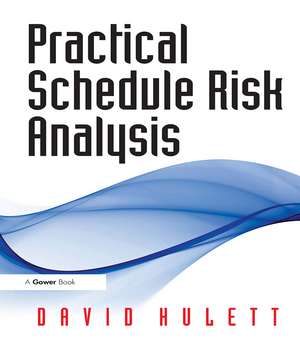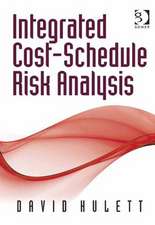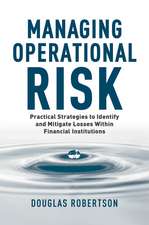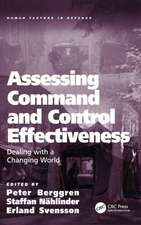Practical Schedule Risk Analysis
Autor David Huletten Limba Engleză Paperback – 24 iun 2024
| Toate formatele și edițiile | Preț | Express |
|---|---|---|
| Paperback (1) | 234.63 lei 6-8 săpt. | |
| Taylor & Francis – 24 iun 2024 | 234.63 lei 6-8 săpt. | |
| Hardback (1) | 1005.39 lei 6-8 săpt. | |
| Taylor & Francis – 28 iun 2009 | 1005.39 lei 6-8 săpt. |
Preț: 234.63 lei
Preț vechi: 303.75 lei
-23% Nou
Puncte Express: 352
Preț estimativ în valută:
44.90€ • 48.01$ • 37.43£
44.90€ • 48.01$ • 37.43£
Carte tipărită la comandă
Livrare economică 18 aprilie-02 mai
Preluare comenzi: 021 569.72.76
Specificații
ISBN-13: 9781032837963
ISBN-10: 1032837969
Pagini: 240
Dimensiuni: 174 x 246 x 17 mm
Greutate: 0.44 kg
Ediția:1
Editura: Taylor & Francis
Colecția Routledge
Locul publicării:Oxford, United Kingdom
ISBN-10: 1032837969
Pagini: 240
Dimensiuni: 174 x 246 x 17 mm
Greutate: 0.44 kg
Ediția:1
Editura: Taylor & Francis
Colecția Routledge
Locul publicării:Oxford, United Kingdom
Cuprins
Chapter 1 Why Schedule Risk Analysis? Looking Beyond the Critical Path Method; Chapter 2 Uncertainty in Activity Durations: Using Probability Distributions; Chapter 3 Uncertainty Along a Schedule Path: Using Monte Carlo Simulation; Chapter 4 A Good Project Schedule is Needed: Critical Path Method Scheduling 101; Chapter 5 Collecting Risk Data: Exploring Methods and Problems; Chapter 6 Where Parallel Paths Merge: Introductionducing the 'Merge Bias' and Risk Criticality; Chapter 7 Probabilistic Branching: Analyzing Discrete Risk Events; Chapter 8 Using Risks to Drive the Analysis and Prioritize Risks: Introductionducing the 'Risk Driver' Method; Chapter 9 Schedule Contingency Plans: Using Conditional Branching; Chapter 10 When Activity Durations Move Together: Incorporating Correlation; Chapter 11 Risk Management in the Organization: Identifying the Mature Risk Management Culture;
Notă biografică
David T. Hulett is internationally recognised as a leading expert in risk management, leader in risk management activities of the Project Management Institute (project manager of the Risk Management chapter of the PMBOK�‚® Guide, 2000 and 3rd editions), deputy PM of the Practice Standard for Project Risk Management (ongoing) and frequent conference speaker. He has a consulting and training practice with clients in many industries around the world.
Recenzii
This is an extremely important book, which presents a depth of understanding of estimating and scheduling rarely seen in industry. It explains the techniques used in a number of schedule analysis software packages, and encourages a more mature approach to understanding the information presented by a project schedule. It should be required reading for all project managers, schedulers, and risk practitioners; and also for programme managers, sponsors, and all staff involved in contracting for project delivery. John Greenwood, PMP on Arraspeople.co.uk ''This is a well documented and extensively illustrated text that takes novice and expert alike on a journey of discovering on how to handle risk and uncertainty when they apply to project activity durations ... By having each math exercise direct to apply to examples of schedule management, we arrive at the added business value of increased certainty for project duration almost before we realize that it was those simulated 5,000 random iterations that got us there... Dealing with schedule risk requires serious attention. This serious volume addresses the subject in an intelligent and instructive manner.' - Cost Engineering, Journal of the AACE 'The book being organized into eleven chapters has a broad and in-depth coverage of the subject matter...The book seeks to encourage and promote the need for project schedulers and project managers to develop practical as well as thorough competencies...Another impressive perspective is the inclusion of a novel way to take account of risks in schedule risk analaysis models called the 'Risk Driver' method - a powerful way of mapping risks to activities...The book provides an interesting read.' - PM World Today
Descriere
Practical Schedule Risk Analysis, contains a complete treatment of schedule risk analysis from basic to advanced concepts. Benefits of the process, relationship to traditional critical path method scheduling and to project management, the role of the corporate culture in ensuring success and the criticality of collecting risk data are emphasized fo



















